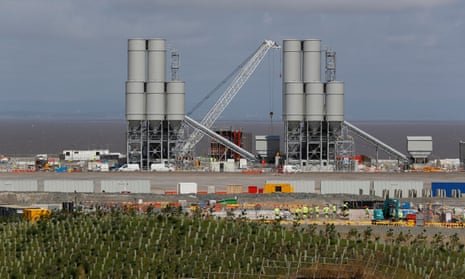The cost of building the UK’s first new nuclear power plant in a generation has risen by up to £2.9bn and the total bill could be more than £22bn.
EDF Energy said the construction cost for Hinkley Point C in Somerset had climbed by between £1.9bn to £2.9bn from the company’s last estimates and is running the risk of further delays.
As a consequence, the total cost has risen from £19.5bn to between £21.5bn and £22.5bn.
The nuclear developer blamed challenging ground conditions, which made earthworks at the site more expensive than it expected.
The French company also misjudged the cost of adapting its new pressurised water reactor design to meet UK nuclear regulation standards. EDF is using the same reactor design at the Olkiluoto nuclear project in Finland and at Flamanville in France, where costs have also spiralled by billions of euros.
EDF Energy’s strategy director, Paul Spence, told BBC Radio 4 that he “can’t be sure today” that there won’t be further cost increases at Hinkley Point, which is due to start supplying 7% of the UK’s electricity by 2025.
He said: “The important point for me to make is that those costs are not costs that hit the consumer, they are costs that come to us as shareholders in the project.”
In a letter to staff, EDF Energy’s chief executive, Simone Rossi, said Hinkley’s cost overruns will “not add a penny” to energy bills or raise costs for the taxpayer.
The project has a government contract that guarantees a set price of £92.50 for every megawatt hour of electricity produced and was “designed with the risks of a first-of-a-kind project in mind”, he said.
The set price is high enough for EDF Energy to remain in line for healthy shareholder returns from the Hinkley Point project despite its rising costs.
The Guardian understands that the latest cost increase brings EDF Energy’s internal rate of return down to between 7.6% and 7.8%. The project originally offered a 9% return on investment, which slipped to 8.5% after its 2017 cost review.
However, the rising costs have raised questions over plans to fund a follow-up nuclear project at Sizewell C using a different financing model to Hinkley, which would put taxpayers on the hook for rising costs.
Ministers hope t a regulated asset base, or Rab, model will make the projects cheaper by shifting the risk of rising costs from the developer to billpayers.
The model helps cut the upfront costs of large infrastructure projects by allowing developers to start claiming their investment back from consumers at an agreed rate before the project is complete.
The model has been used to fund the Thames Tideway project, which will be completed by 2023 but has already raised water bills by £20-25 a year.
The model has found favour in the City for offering investors the promise of steady, long-term returns. Infrastructure investors, in particular, are understood to be eager for an alternative to the regulated energy and water sectors. Both of which are under pressure to cut profits or risk a run-in with regulators or renationalisation under a Labour government.
Critics of the plan said using a Rab model for a nuclear project could mean higher risks for billpayers if there are delays.
Jonathan Marshall, an analyst at the Energy and Climate Intelligence Unit (ECIU), said the “apparent inability” of the nuclear industry to deliver projects on time and on budget will be a “cause for concern” if the Rab model is adopted.
“New delays and cost overruns highlight why there are concerns around transferring more construction risk of new nuclear power stations ,” Marshall added.
Hinkley’s latest cost overrun has also reignited debate over whether the government should pursue an expensive nuclear renaissance while the cost of renewable energy becomes cheaper.
The cost of supporting new offshore windfarms from the mid-2020s fell to record lows of about £40 per megawatt hour of electricity last week in an auction for government contracts, less than half the cost of Hinkley Point C.
Doug Parr, chief scientist at Greenpeace UK, said: “The new Hinkley nuclear plant looked like a bad idea when it was first proposed, and it’s got worse ever since. New offshore wind now costs less than half as much as Hinkley, and it might get even cheaper by the time the much-delayed reactors crank into action.”
He said it has become overwhelmingly clear that an energy system run on renewables would be the cheapest, fastest and most reliable way to cut carbon emissions.
